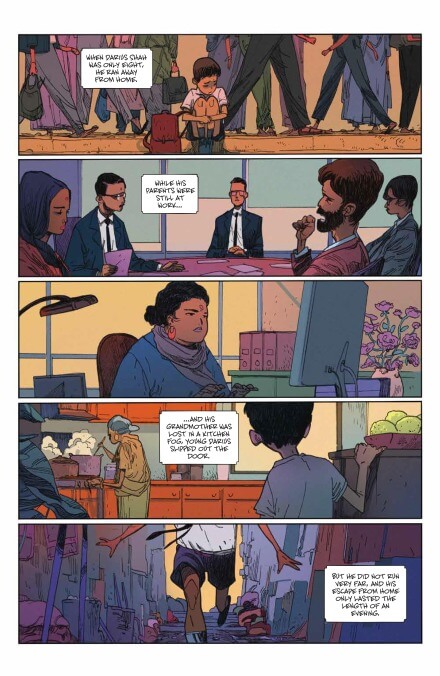The Many Deaths Of Laila Starr is a work of cyclical transcendence

The Many Deaths Of Laila Starr is almost too timely a read as the COVID-19 pandemic still ravages the world. The key plot point—a supernatural representation of Death becomes mortal and hijinks ensue—echoes the character of Death Of The Endless created by Neil Gaiman and Mike Dringenberg, and the first issue even closes with a line reminiscent of Sandman’s “You get a lifetime.” But Laila Starr adds an additional layer of interest more in tune with death as it is now, by exploring the bureaucracy of death. While Ram V was influenced by India’s bureaucratic approach to death, especially in Mumbai (a city he keeps coming back to in his work), and the governmental abandonment of India during the pandemic is particularly striking, many people the world over have now forcibly encountered a bureaucratic approach to mass death.
Yet The Many Deaths Of Laila Starr is actually narrated by Pranah, the god of life. In its first two issues, meticulous care is put into showing how life illuminates itself against the larger backdrop of death. In the latest issue, 8-year-old Darius (the foretold “world-changer” who will usher in immortality and make Death redundant) loses Bardhan, a mysterious man that the younger character admired. Bardhan, who is dark-skinned, from South India, and presumably of a different caste than Darius, is rendered by Filipe Andrade and Inês Amaro in the comic’s signature European comics style; the broadly juxtaposed red-and-blue color scheme of the pages allows for more subtlety than one would imagine. The moment when young Darius is confronted with the fleeting nature and sanctity of life is rendered by introducing Bardhan as visually parallel to a tree that Darius is grasping, and then, in the next panel, drawn gigantic (Bardhan’s skin and the bark given a similar tone) as if he, himself, were a looming tree. In the next, Darius is atop his shoulders. It’s powerfully affecting.
So far, the comic celebrates the subtlety of life against the rigidity of death. Rigidity is internally represented by the frequent inclusion of Mumbai’s skyscrapers—even the gods work in a silver tower. When the unnamed chief deity, presumably Brahma, is introduced, three windows are behind him, mirroring the paneling of the upper and lower tiers of the page. Panels, too, often break up continuous images, perhaps relating to how the rigidity of death breaks up life. This is reinforced by the dearth of images bleeding into the gutters; in fact, the only moment of bleeding, so far, is when Death is incarnated into the dead body of Laila Starr. Yet even with this rigidity, emphasizing how futile life might seem against death, most of the panels feature extreme close-ups, pushing against the panel borders, as if the life within the panels is eagerly attempting to burst out.
It’s through these little, affirming details that the team manages to surprise the reader, despite the seemingly cyclical nature of The Many Deaths Of Laila Starr. And the comic, it seems, is quite cyclical: Both issues begin with Laila Starr isolated, followed by a focus on Darius. The two of them then have an encounter in which she fails to kill him, and Laila has some sort of experience with a ghost that directly or indirectly leads to her death; she dies, and is resurrected sometime later by Pranah. Of course, the very next issue could disprove this theory, but this excellent comic practically demands that one being purchased as well, to find out.
